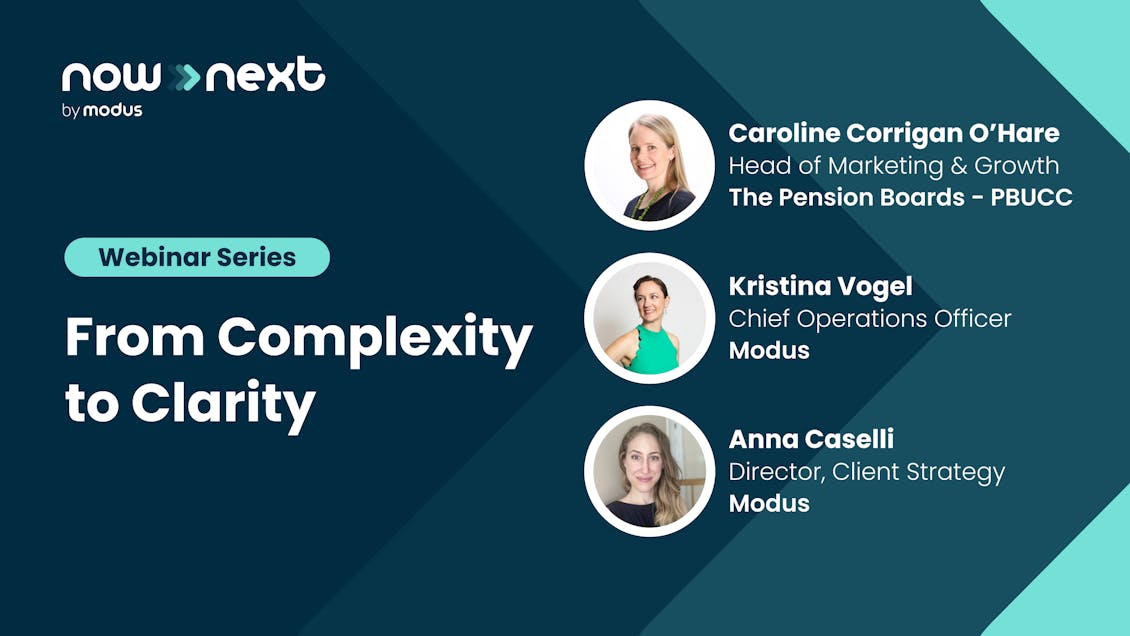Webinar recap: From Complexity to Clarity

How to have strategic priorities from the inside out.
As digital leaders prepare to roll out 2025 initiatives to stay ahead of competition and meet customer demand, how can they best position their teams for success?
This was the topic of our latest Now & Next webinar, “From Complexity to Clarity: Enhancing Efficiency and Customer Experience.” Modus’s Kristina Vogel, Chief Operating Officer, and Anna Caselli, Director of Client Strategy, with our client, Caroline Corrigan O'Hare, Head of Marketing and Growth at The Pension Boards–United Church of Christ, Inc., discussed how to navigate the increasing complexity of large-scale digital projects.
A 2023 survey by Oliver Wyman found that only 25% of companies that attempted a digital transformation program in the past three years successfully met their goals. At Modus, one of the biggest bottlenecks we see with our clients are silos between teams such as operations, information security, sales, and marketing. “This interferes with our mission to deliver that superior experience,” said Kristina.
In order for organizations to solve the complexities surrounding their technology and processes, people have to be at the center of transformation, the panel agreed. Read on and watch the full episode to learn how leaders can be more proactive and forward-thinking to align on clarity as an organizational goal.
Watch the full webinar to learn:
- How to simplify operations and improve efficiency while focusing on customer needs
- The value of iterative processes and continuous improvement for implementing tools and technologies
- How to keep the customer story at the heart of large initiatives
Break down silos to drive strategic priorities
Even with the most advanced technology, organizations need a culture built around collaboration to adapt to change. Caroline shared how, following the 2008 financial crisis, traditional media-first marketing methods were becoming outdated. Attracting audiences in a digital-first way required sales and marketing teams to listen and learn from each other to meet a challenging market.
“Be really curious about how all the different specialties that you have can be put together to create a better experience,” said Caroline. “It really starts with who is your audience? Where are they at today? What are your goals and objectives to help them get to the next stage that benefits them?”
Kristina raised the importance of interdisciplinary teams to help keep user goals at the forefront, and she mentioned Modus’s own internal information security team as an example. “We've centralized infosec with an interdisciplinary team that includes a product manager, DevOps, and operations, and then we allow our client teams to treat that as a service … to meet compliance obligations,” she said.
“We don't want to set up these adversarial business units where they're working against each other,” Kristina continued. “That slows down our timelines, increases budgets, and everything else. So we want you to feel that it's a service that you can call upon, and it's going to be ready when you need it.”
Keep the end goal in mind when mapping the customer experience
When planning which tactics to use to improve the customer experience (CX), organizations will often zero in on a key touchpoint. That can prove to be short-sighted, said Caroline.
She shared how she hears a number of competing priorities from her teams, from promotional campaigns to updating the website. “There are a lot of moving pieces,” she said. By digging into all of the touchpoints that make up the customer journey, organizations can better guide their audience to desired outcomes.
“It's not so much about designing the website or implementing [a tool],” said Caroline. “It’s how do we put all these tools across the entire experience that we're creating for them, and avoid the bottlenecks.”
Set the stage for scalability and continuous improvement
The digital era demands that we constantly learn new kinds of skills and expertise, from AI to cybersecurity. Continuous training and communications around the importance of staying adept are key to ensuring organizations can meet the moment.
Kristina emphasized the importance of strengthening organizational scalability — “not to take it all on, but to lay the foundation for more.”
“This is important when we're considering how we might use AI in the future,” she said, highlighting the need to remove organizational debt that can get in the way of an ideal customer experience.
Anna shared that having the foundational processes and governance in place to use AI has allowed her teams to analyze large amounts of customer data safely. By implementing conversational interfaces to interact with the data, “you're really unlocking a lot of insights that different team members maybe didn't have accessible to them before,” she said.
Caroline said that for her team, AI is another tool in the toolkit. “It's another piece in the puzzle now,” she said. “Except the puzzle is not 500 pieces— it’s 750,000-piece puzzles. And how do we put those together in a modern world?”
In closing, Caroline shared how she is inspired by her grandmother, who lived to age 102, to never get comfortable. “Everything we do these days is iterative,” she said. “Don't get too caught up in anything being completely perfect. Be willing to be iterative and to phase things over time, and to learn and to optimize and to find good partners who will help you do that.”

